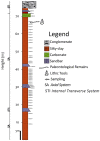New magnetostratigraphic evidence for the age of Acheulean tools at the archaeo-palaeontological site "Solana del Zamborino" (Guadix - Baza Basin, S Spain)
- PMID: 29044215
- PMCID: PMC5647401
- DOI: 10.1038/s41598-017-14024-5
New magnetostratigraphic evidence for the age of Acheulean tools at the archaeo-palaeontological site "Solana del Zamborino" (Guadix - Baza Basin, S Spain)
Abstract
The sedimentary record in the Guadix-Baza Basin (southern Spain) has proved to be a great source of information for the Miocene through the Pleistocene periods, due to the abundant faunal remains preserved, in some cases associated with lithic tools. The Solana del Zamborino (SZ) section has been the subject of controversy ever since a magnetostratigraphic analysis resulted in an age of 750-770 Kyr for Acheulean tools, a chronology significantly older than the ~600 Kyr established chronology for the first Acheulean record in Europe. Although recent findings at the "Barranc de la Boella" site (north-east of the Iberian Peninsula) seem to indicate that an earlier introduction of such technique in Europe around 0.96-0.781 Ma is possible, the precise age of the classical site at SZ is still controversial. The aim of this paper is to constrain the chronology of the site by developing a longer magnetostratigraphic record. For this purpose, we carried out an exhaustive sampling in a new succession at SZ. Our results provide a ~65 m magnetostratigraphic record in which 4 magnetozones of normal polarity are found. Our new magnetostratigraphic data suggest an age range between 300-480 Kyr for the lithic tools, closer to the age of traditional Acheulean sites in Europe.
Conflict of interest statement
The authors declare that they have no competing interests.
Figures








Similar articles
-
Age and date for early arrival of the Acheulian in Europe (Barranc de la Boella, la Canonja, Spain).PLoS One. 2014 Jul 30;9(7):e103634. doi: 10.1371/journal.pone.0103634. eCollection 2014. PLoS One. 2014. PMID: 25076416 Free PMC article.
-
Chronological and environmental context of the first hominin dispersal into Western Europe: The case of Barranco León (Guadix-Baza Basin, SE Spain).J Hum Evol. 2015 Oct;87:87-94. doi: 10.1016/j.jhevol.2015.02.014. Epub 2015 Apr 13. J Hum Evol. 2015. PMID: 25883051
-
Bio- and magnetostratigraphic correlation of the Miocene primate-bearing site of Castell de Barberà to the earliest Vallesian.J Hum Evol. 2019 Jul;132:32-46. doi: 10.1016/j.jhevol.2019.04.006. Epub 2019 May 10. J Hum Evol. 2019. PMID: 31203850
-
Ten years in the dump: An updated review of the Miocene primate-bearing localities from Abocador de Can Mata (NE Iberian Peninsula).J Hum Evol. 2017 Jan;102:12-20. doi: 10.1016/j.jhevol.2016.09.012. Epub 2016 Nov 11. J Hum Evol. 2017. PMID: 28012461 Review.
-
The origins of the Acheulean: past and present perspectives on a major transition in human evolution.Philos Trans R Soc Lond B Biol Sci. 2016 Jul 5;371(1698):20150245. doi: 10.1098/rstb.2015.0245. Philos Trans R Soc Lond B Biol Sci. 2016. PMID: 27298475 Free PMC article. Review.
Cited by
-
Did the Romans introduce the Egyptian mongoose (Herpestes ichneumon) into the Iberian Peninsula?Naturwissenschaften. 2018 Oct 11;105(11-12):63. doi: 10.1007/s00114-018-1586-5. Naturwissenschaften. 2018. PMID: 30311012
-
First evidence of an extensive Acheulean large cutting tool accumulation in Europe from Porto Maior (Galicia, Spain).Sci Rep. 2018 Feb 15;8(1):3082. doi: 10.1038/s41598-018-21320-1. Sci Rep. 2018. PMID: 29449566 Free PMC article.
-
The earliest evidence of Acheulian occupation in Northwest Europe and the rediscovery of the Moulin Quignon site, Somme valley, France.Sci Rep. 2019 Sep 11;9(1):13091. doi: 10.1038/s41598-019-49400-w. Sci Rep. 2019. PMID: 31511611 Free PMC article.
References
-
- Soria J, Viseras C, Fernández J. Late Miocene-Pleistocene tectono-sedimentary evolution and subsidence history of the central Betic Cordillera (Spain): a case study in the Guadix intramontane basin. Geol. Mag. 1998;135:565–574. doi: 10.1017/S0016756898001186. - DOI
-
- Soria J, Fernández J, Viseras C. Late Miocene stratigraphy and paleogeographic evolution of the Guadix intramontane Basin (Central Betic Cordillera, Spain): implications for Atlantic-Mediterranean connection. Palaeogeogr. Palaeoclimatol. Palaeoecol. 1999;151:255–266. doi: 10.1016/S0031-0182(99)00019-X. - DOI
-
- Viseras C, Soria JM, Fernández J, García García F. The Neogene-Quaternary basins of the Betic Cordillera: an overview. Geophys. Res. Abstr. 2005;7:1–5.
-
- Viseras C, Soria J, Durán J, Arribas A. Condicionantes geológicos para la génesis de un yacimiento de grandes mamíferos: Fonelas P-1 (límite Plioceno-Pleistoceno, Cuenca de Guadix-Baza, Cordillera Bética) Boletín Geológico y Min. 2004;115:551–566.
-
- García-Aguilar JM, Palmqvist P. A model of lacustrine sedimentation for the Early Pleistocene deposits of Guadix-Baza basin (southeast Spain) Quat. Int. 2011;243:3–15. doi: 10.1016/j.quaint.2011.02.008. - DOI
Publication types
MeSH terms
LinkOut - more resources
Full Text Sources
Other Literature Sources

